Your cart is currently empty!
Facts to Know About CBD
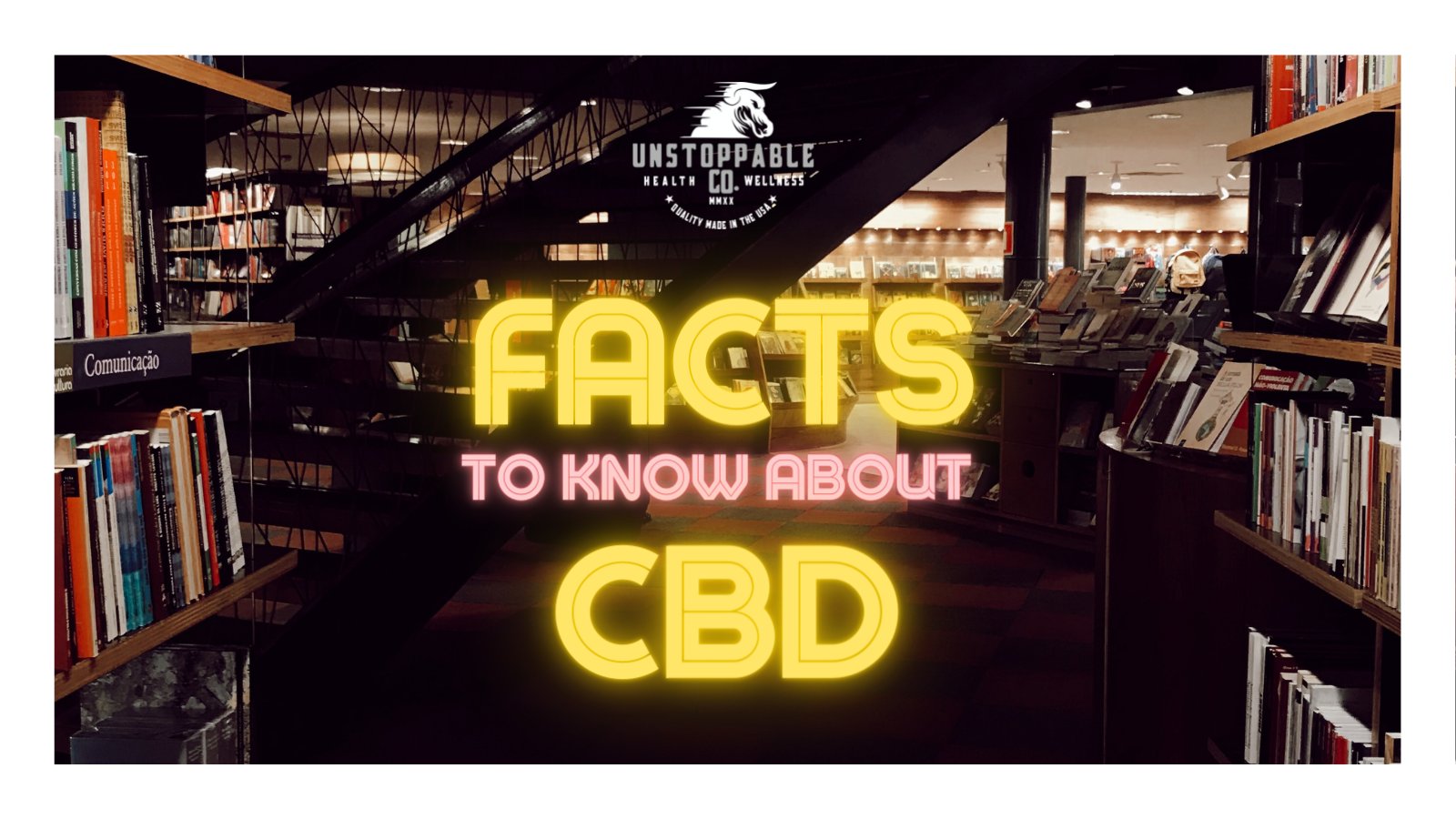
You’ve seen it at the checkout at Whole Foods. You’ve heard about it from people in all different demographics — from your teenage neighbor to your grandmother. You are curious, but overwhelmed by all the information out there. So what do you need to know before trying CBD for the first time?
Products with CBD — or cannabidiol — have reached a saturation point. That’s a good and bad thing. It’s good because greater availability means more choice of different products to try. It’s bad because there’s still a lot of misinformation out there.
Everyone wants to talk about CBD these days. But a lot of the talk you hear at this stage is aimed at people who have already “made the leap.” That is, people who know what they want to use CBD for, know what formulation they’re interested in and have an idea of what dosage is appropriate.
Let’s assume you don’t know any of those things. (And that’s OK!) Here’s where the information overload sets in. CBD suffers from an embarrassment of riches when it comes to possible benefits — you’ve probably heard people swear by it when used for pain relief, anxiety control, sleep aid and so much more.
You also probably know that it can be taken in many ways, and in many different dosages. You can apply it to your skin. You can drop it under your tongue. You can take it in pill form — oral or suppository. You can ingest it as a food.
Overwhelmed yet?
This article will take you through the different factors to consider and things to know as you start to embark on your CBD journey.
…Oh, and congratulations! We’d be remiss if we didn’t share our joy and excitement that you’re thinking of taking this step. CBD has changed the lives of so many people already. It’s not unreasonable to think that your life could be transformed by this little miracle substance, too.
FACT #1
IT WON’T GET YOU HIGHThis is the biggest question that most people have when they dive into the world of CBD. Will it get you high?
It’s a marketing and perception problem — many companies trade on the cute cannabis or hemp leaf imagery when advertising their CBD products. As that imagery is strongly associated with marijuana and its psychoactive effects, you can see where the confusion comes in.
The key to this issue lies in understanding the difference between the cannabinoids THC and CBD. But let’s back up.
What is a cannabinoid? It’s simply a chemical compound found in cannabis. There are at least 113 different cannabinoids present in the cannabis plant, and they each exhibit different effects. But let’s not worry about 111 of those cannabinoids — the two most common ones — and the ones you hear about the most — are tetrahydrocannabinol (THC) and Cannabidiol (CBD).
Cultural stereotypes around marijuana are primarily centered on the effects of THC, as it’s the primary psychoactive compound. When people talk about losing their short-term memory, exhibiting slowed reaction time, laughing uncontrollably, getting the “munchies,” feeling relaxed or even more extreme outcomes like hallucinating or paranoia — those are symptoms directly attributable to the consumption and metabolism of THC.
These images are indelible in the public memory. From the propaganda film Reefer Madness to the use of “stoner” as an insulting term to countless anti-drug campaigns across the years — marijuana has been strongly negatively associated with those famous effects of THC.
It’s only been in recent years that CBD — another prominent but totally different compound in cannabis — has been widely talked about.
As mentioned earlier, popular imagery — such as the iconic hemp or cannabis leaf — has been extensively used in the marketing of CBD products. Who can blame people for getting confused, as such imagery has already been used for decades as a symbol of the effects of THC!
The key difference between CBD and THC is that CBD is non-psychoactive. This is a relatively new science, by the way — the 2015 study called “A systematic review of the antipsychotic properties of cannabidiol in humans” (Schizophrenia Research)[1] found that CBD actually counteracts the cognitive impairment that is widely associated with the use of cannabis. In fact, early research seems to suggest that CBD might have an antipsychotic effect; this understanding is still developing.[2]
Long story short: As long as you choose CBD products with Zero THC, you will not be experiencing the “high” sensation commonly associated with marijuana use.
FACT #2:
IT MIGHT HELP WITH A SURPRISING NUMBER OF HEALTH ISSUESWe touched on a few of the common reasons people take CBD.
Here’s an encouraging addendum to that: CBD is an incredibly utilitarian substance that can help you combat a truly staggering number of problems — and more benefits are being discovered every day.
CBD is a popular source of relief for the following frustrating problems:
- Headaches
- Menstrual cramps
- Chronic, stubborn or unexplained pain
- ADHD
- Pet behavioral issues or anxiety
- Insomnia
- PTSD
- Inflammation
- Alzheimer’s
- Parkinson’s
- Epilepsy
- Lack of appetite
- And much, much more — new uses are being discovered every day
FACT #3:
METHOD AND DOSAGE ARE IMPORTANTFor way too long, the CBD industry was in the habit of recommending to consumers that they use the trial-and-error method in order to determine what concentration of CBD would provide the best benefit.
See a problem with this?
Humans are not guinea pigs!
We will cover the specifics of dosage and concentration — including what the milligram measurements mean and what the differences might be when you try different applications of CBD — in a future article.
Which brings us to the issue that goes hand-in-hand with dosage: method. Will you take softgels, tinctures, suppositories, gummies or something else to get your CBD?
Thankfully, this question is a little less complex than the issue of dosage. To oversimplify the answer, we will start by saying that the most important thing is sustainability. Hate taking pills? Then perhaps our softgels aren’t for you. Are you squeamish about putting things in your body? Then suppositories may not be the ticket. The list of considerations can go on — for example, will you be administering the CBD to someone or having it administered to you? That can, of course, impact what type of delivery mechanism you might want to consider.
Take an educated guess about what might work for you, and don’t be afraid to reach out to us for assistance — we’re always here to help.
FACT #4:
THE FEDERAL GOVERNMENT IS SHOWING MORE AND MORE SUPPORT FOR THE CBD INDUSTRY EVERY DAYYou’re a responsible person. Naturally, due to the longtime negative association with marijuana and illegality, you want to be sure that CBD products are “OK” to take. You wonder: Will using CBD products get you in trouble with your job? Could they get you in trouble with the law?
The legislation is ever-evolving – but take heart. The 2018 Farm Bill legalized hemp with 0.3% or less THC legal in the U.S. CBD is not a controlled substance, and therefore it is completely legal to grow, distribute and sell it.
Unstoppable takes legal issues and federal rules extremely seriously. We sell high-quality CBD products to responsible people like you, and we follow all applicable laws and regulations.
FACT #5:
ALL PRODUCTS ARE NOT CREATED EQUAL!If you take one piece of knowledge from this article, it should be this: CBD products are only as good as the company that sells them.
Yes, we said it. There’s a lot of junk out there. So when you’re ready to try CBD for the first time, keep this key piece of advice in mind: Check for the Certificate of Analysis!
The COA is an independent evaluation from a third-party lab that speaks to the purity and potency of each product. CBD companies are not required to invest in COAs for their products — and for that reason, many do not.
Unstoppable believes you deserve better. We have invested in third-party lab testing. We have made our third-party COAs available so that you can review exactly what you’re getting with each product. The COAs will also clue you into critical information such as the presence (if any) of pesticides, toxins, residual solvents and more.
In our humble opinion, COAs are not optional for any honest CBD company that respects its customers.
And there you have it: These are the most important facts and factors to consider when you’re thinking about trying CBD for the first time. What product are you most interested in trying first?
[1] https://www.ncbi.nlm.nih.gov/pubmed/25667194
[2] https://linkinghub.elsevier.com/retrieve/pii/S0006322315009956
Unstoppable Support
The Science Behind CBD | Unstoppable Health & Wellness
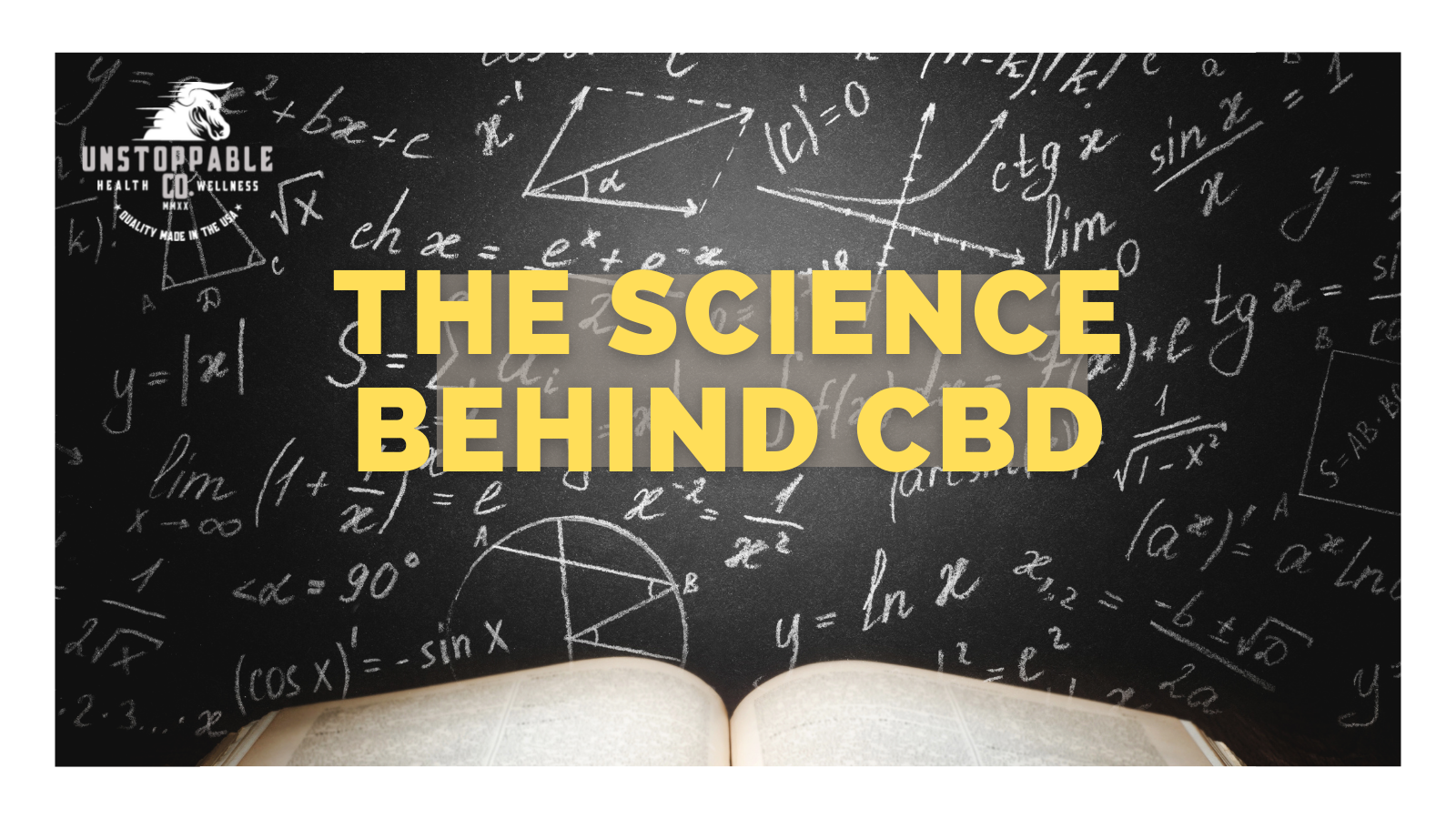 Test tubes. Beakers. Unflattering lab coats and vaguely toxic chemical smells.
Test tubes. Beakers. Unflattering lab coats and vaguely toxic chemical smells.Are you flashing back to your high school science class yet?
We don’t mean to be nerds, but we get asked often about the science behind CBD. Sure, we love to geek out about chemical receptors, neurotransmitters and super-precise DNA tests.
But we totally understand that most people want a brief and easy-to-understand overview of the science behind CBD in order to decide whether it’s safe (our answer: it is!), whether it works (same thing: it does!) and what you can expect when you take it (we’ll walk you through this one).
Without further ado, please don your lab coat and join us …
SCIENCE LESSON #1:
WHAT EXACTLY IS CBD?Cannabidiol, or CBD, belongs to a class of plant chemical compounds called cannabinoids. There are at least 113 known cannabinoids that have been isolated from cannabis, of which CBD and tetrahydrocannabinol (THC) are the most common and the most well-known. CBD can account for up to 40% of a cannabis plant’s extract.
CBD differs from THC in that CBD is non-psychoactive, meaning it won’t get you high. CBD has exploded in popularity lately because clinical research suggests that it may have positive effects when taken to counteract anxiety, movement disorders, epilepsy and pain. CBD may also help improve cognition and mood.
Interestingly, when CBD and THC are taken together, CBD may reduce the adverse effects of THC on your body. (Important note: Unstoppable CBD products do not contain THC — they are certified Zero THC, meaning there is less than 0.3% of the compound in each of our products.) This research is still developing.
SCIENCE LESSON #2:
WHAT IS THE ENDOCANNABINOID SYSTEM?Now that we’ve covered the broad strokes of what CBD is, let’s begin to talk about how it interacts with your body’s systems.
The starting point for this discussion must be the endocannabinoid system. Called ECS for short, the endocannabinoid system is a natural bodily system made up of endocannabinoids and cannabinoid receptor proteins. To put things as simply as possible, endocannabinoids are neurotransmitters that bind to cannabinoid receptors; cannabinoid receptor proteins are sites all over the vertebrate central nervous system and peripheral nervous system.
Don’t remember learning about the ECS in high school? That’s not surprising — it has only recently been discovered and studied, and scientists are still in the process of learning about its true potential.
Here’s a quick, high-level rundown of the ECS. There are two primary endocannabinoid receptors that have been identified: CB1 and CB2. (To give context — each of these receptors was first cloned in the 1990s.)
You’ll find CB1 receptors predominantly in the brain and nervous system, plus in peripheral organs and tissues. THC binds with CB1, setting off a chain reaction that makes you feel the effects of the THC.
CBD, on the other hand, is active at both cannabinoid receptors (CB1 and CB2). Scientists have noted that when CBD binds to either of the cannabinoid receptors, there can be a profound effect on the regulation of appetite, immune function and pain management.[1]
SCIENCE LESSON #3:
WHAT HAPPENS IN YOUR BODY WHEN YOU TAKE CBD?
OK, you’ve made it this far in the article, so let’s get to the really good stuff! In our high school science class analogy, think of this as the big final lesson — the one that ties it all together. (We think you’re ready for it!)
Want to know exactly what CBD does when it enters your body? Here’s what we know so far about how this exciting compound interacts with our various systems. Remember, as with a lot of things relating to CBD — this is a developing science, with more and more exciting information being uncovered each day.
YOUR BODY ON CBD:
WHAT’S GOING ON WHEN YOU TAKE IT?These are the four main reactions that occur in your body when you take CBD — along with explanations for what the implications are.
- CBD binds with various neuroreceptors and channels in the brain and nervous system. The impact is cumulative — meaning you’ll feel the effects of these binding events more and more as you take higher concentrations of CBD. CBD can bind with neuroreceptors that regulate the release of mood-related neurotransmitters like dopamine, glutamate and serotonin. CBD can also bind with body regulation-related neuroreceptors like vanilloid. This binding can affect your body temperature, perception of pain and inflammation levels.
- CBD deactivates GPR55. GPR55 — a so-called “orphan receptor” — can affect your blood pressure, the density of your bones and the growth of cancer cells.
- CBD works to raise the level of endocannabinoids in your brain through an inhibition cycle. CBD can block the “reuptake” of the neurotransmitter anandamide. This is thought to provide anti-anxiety and anti-inflammation benefits, as anandamide reuptake inhibition has an effect on vasodilation and heart function.
- For cancer patients: CBD activates peroxisome proliferator activated receptors, or PPARs, which slows the spread of harmful cells and can cause tumors to go into regression. This particular benefit is still being examined for potential in treating Alzheimer’s, diabetes and metabolism disorders.
PUTTING IT ALL TOGETHER:
SCIENCE SHOWS THRILLING CBD POTENTIALThe CBD industry has grown astronomically in recent years. While the explosion started by word-of-mouth — with many people sharing the details of how their lives were improved by using CBD products — CBD has now earned its place in the sun, with the detailed, evidence-based science to back the most exciting claims up
We’re happy to change people’s lives with our CBD products, and we believe the best way to do that is to analyze, quantify and to keep searching constantly for the best possible ways to help.
Now that you have a solid foundation on the science of CBD products, there’s one thing left to do. Your personal experience will be unique to you, so try them out! What products are you most looking forward to trying?
Unstoppable Support
Equestrians and de Quervain’s Tenosynovitis: Causes and Solutions to R

As an equestrian, you are likely no stranger to wrist pain. Due to the extreme pressure and strain on the wrists, many horseback riders suffer from an inflammatory condition known as de Quervain’s Tenosynovitis, which causes pain at the base of your thumb and the wrist area.
While this can occur in any rider, it tends to peak between ages 40-60, putting mature horse riders at a severe risk of wrist pain and even injury.
So, what can we do about this condition and continue to ride without pain? Let’s learn more about de Quervain’s Tenosynovitis and the natural solutions that can help.
What is de Quervain’s Tenosynovitis?

De Quervain’s tenosynovitis syndrome affects the tendons in the wrist. A tendon is a hard band of connective tissue that connects a muscle to a bone.
This condition occurs when the tendons at the base of your thumb experience swelling. This swelling causes the outer covering (sheaths) of the tendons to become inflamed, and this inflammation then causes pain and numbness as it puts pressure on nearby nerves.
Symptoms of de Quervain’s Tenosynovitis
Also known as the ‘Gamer’s thumb’, the main symptom of de Quervain’s tenosynovitis is severe pain and tenderness in your lower thumb. Difficulties in performing activities that include grasping, twisting, and lifting an object have also been commonly reported.
This condition significantly restricts the movement of the thumb and wrist making it a huge issue for equestrians.
Other symptoms also include:
- Swelling near the base of the thumb
- Numbness in adjacent finger and the back of the thumb
- Feeling of a snap or a click while moving the thumb
What Causes de Quervain’s Tenosynovitis in Equestrians?
Constant overuse of the wrist and thumb that is common in horseback riders is considered the most common cause of de Quervain’s tenosynovitis. Repetitive actions can stress the same area over and over, which increases the irritation and pain in the wrist and thumb.
The basic principles of horseback riding include correct thumb and arm posture. Equestrians also perform sustained periods of wrist bending, extreme wrist postures, and repetitive hand movements while horse riding which makes them easily exposed to this condition. Jarring of the wrist is another common issue in riders which can increase the inflammation and pain in the entire wrist joint.
In addition to being a rider, you may be more susceptible to developing de Quervain’s tenosynovitis if you:
- are over 40 years of age
- have a hobby or job surrounding repetitive hand and wrist motions (for example- carpenters, dentists, musicians, office workers)
- have a previous injury in the same area
- suffer from arthritis
Topical CBD to Help Relieve de Quervain’s Tenosynovitis
When treating de Quervain’s tenosynovitis, experts focus on reducing pain and swelling by lowering tendon sheath inflammation. This is where topical CBD can be an excellent asset, as it can reduce inflammation to speed up healing.
Equestrians have been turning towards topical CBD, a less invasive way of dealing with these sorts of injuries. It helps with:
-
Muscle Recovery
Topical CBD includes lotions, ointments, and creams infused with Cannabidiol to aid muscle recovery. It also accelerates the recovery process helping horseback riders to return to their job quicker.
-
Pain and Inflammation
CBD helps equestrians in reducing the pain and inflammation caused by this condition by interacting with the brain’s endocannabinoid system. It blocks pain signaling receptors to reach the brain making it a great substitute for over-the-counter anti-inflammatory drugs such as Advil.
-
Lowers Pressure on Injured Muscle
In de Quervain’s tenosynovitis, pain and swelling can even reach the index finger, making it difficult to carry out day-to-day activities. Topical CBD helps to soothe these inflammatory nerve endings and provide relief.
Additionally, other lifestyle habits and treatments pair excellently with a topical CBD product to reduce pain and heal the wrist. Consider adding these to your treatment plan:
- Heat/Ice pack
- Avoiding repetitive hand or wrist motion
- Wearing a splint
- Local anesthetic injection
- Physiotherapy
Don’t Let de Quervain’s Tenosynovitis Stop Your Riding
Wrist pain and swelling can be a nightmare for equestrians who love to ride, but there are helpful options for relief. Topical CBD products like Unstoppable can be a simple, safe, and natural way to relieve pain, reduce inflammation, and prevent further injury in the wrist and other vulnerable areas.
Don’t let wrist pain stop you from enjoying your riding passion. Shop our collection of CBD products to ride pain-free!
Unstoppable Support
Could CBD Help Your Horse, Too?


Many horse riders have found that high-quality CBD products have helped them stay on top of their pain, feel less stressed and tense, and even perform better on the track. CBD offers a simple and safe solution for riders to stay healthy, whether they’re competing or just enjoying the ride.
So, if CBD can help riders conquer pain and stay stress-free, could it help our horses, too? Studies show that CBD does have potential benefits for both horse and rider – let’s take a look!
What is CBD and How Can it Help Horses?
When horses are put through extensive labor, they can develop health alterations that can worsen over time.
But, it can be hard to tell when our horses are experiencing underlying health problems in a horse. For this reason, many choose to help their horses maintain their peak health and fitness by using holistic measures like chiropractic, acupuncture, touch therapy, and supplements.
 To manage horses’ minor health concerns, many horse owners are turning to CBD.
To manage horses’ minor health concerns, many horse owners are turning to CBD.CBD is a compound extracted from hemp. Because it belongs to the cannabis family, it is commonly mistaken as a drug. However, CBD is not a drug (like marijuana and products with high concentrations of THC). Instead, it is a medicinal herb with anti-inflammatory, anticonvulsant, antiemetic, antioxidant, and antipsychotic agents.
The efficiency of CBD in humans and mammals has been observed across the globe. It has encouraged veterinarians and animal lovers to use CBD in animals (including horses) for issues ranging from seizures to separation anxiety to pain.
3 Ways CBD Can Help Your Horse
Horses are very sensitive as compared to other animals. Due to their strenuous routines, they suffer from different kinds of health issues than the average house pet. Here are some of the common and crucial issues that can be treated with the help of CBD:
-
CBD can be used to manage pain
Horses fall prey to different kinds of injuries while running in the fields and on track. They face issues like sprains, fractures, wounded hooves, and more. Some even suffer from conditions like laminitis from carrying their riders.
Research conducted by the Colorado State University concluded when equines and canines were ingested with oral CBD, there was a significant decline in pain in the body. CBD reduces nerve-related pain by curbing the pain signals released by the injured cells and also reducing the swelling in the area.Veterinarians have also used CBD topically to help reduce pain, tension, and inflammation in the horse’s muscles and joints.
-
CBD helps in reducing inflammation
CBD is well-known for having anti-inflammatory abilities. It reduces inflammation by decreasing the inflammatory cytokines that cause autoimmunity, hypersensitivity, and allergies. Because inflammation is a major cause of pain and delayed healing, this also helps to better address sore muscles, chronic stress, and injuries for the horse.
-
Reduces anxiety and stress
Horses can also become stressed when kept in enclosed trailers away from their owner. Normally, horses show a sudden change in mood when they are stressed or anxious. Common symptoms of mood swings include lack of appetite, aggression, and sluggishness.
CBD supplements and topicals have been shown to help reduce stress in both animals and humans.
Ready to Try CBD for Your Horse – Yourself?
 CBD comes in different forms such as tablets, oils, and lotions. If you are considering using CBD with your horse, contact your veterinarian to discuss the best options for your horse’s unique needs.
CBD comes in different forms such as tablets, oils, and lotions. If you are considering using CBD with your horse, contact your veterinarian to discuss the best options for your horse’s unique needs. As riders, we also face issues with pain, tension, injury, and stress. Thankfully, topical CBD products like Unstoppable are easy to use, safe to try, natural, and effective. Learn more about our high-quality CBD here.
Unstoppable Support
-
What is CBD? | Unstoppable Health and Wellness
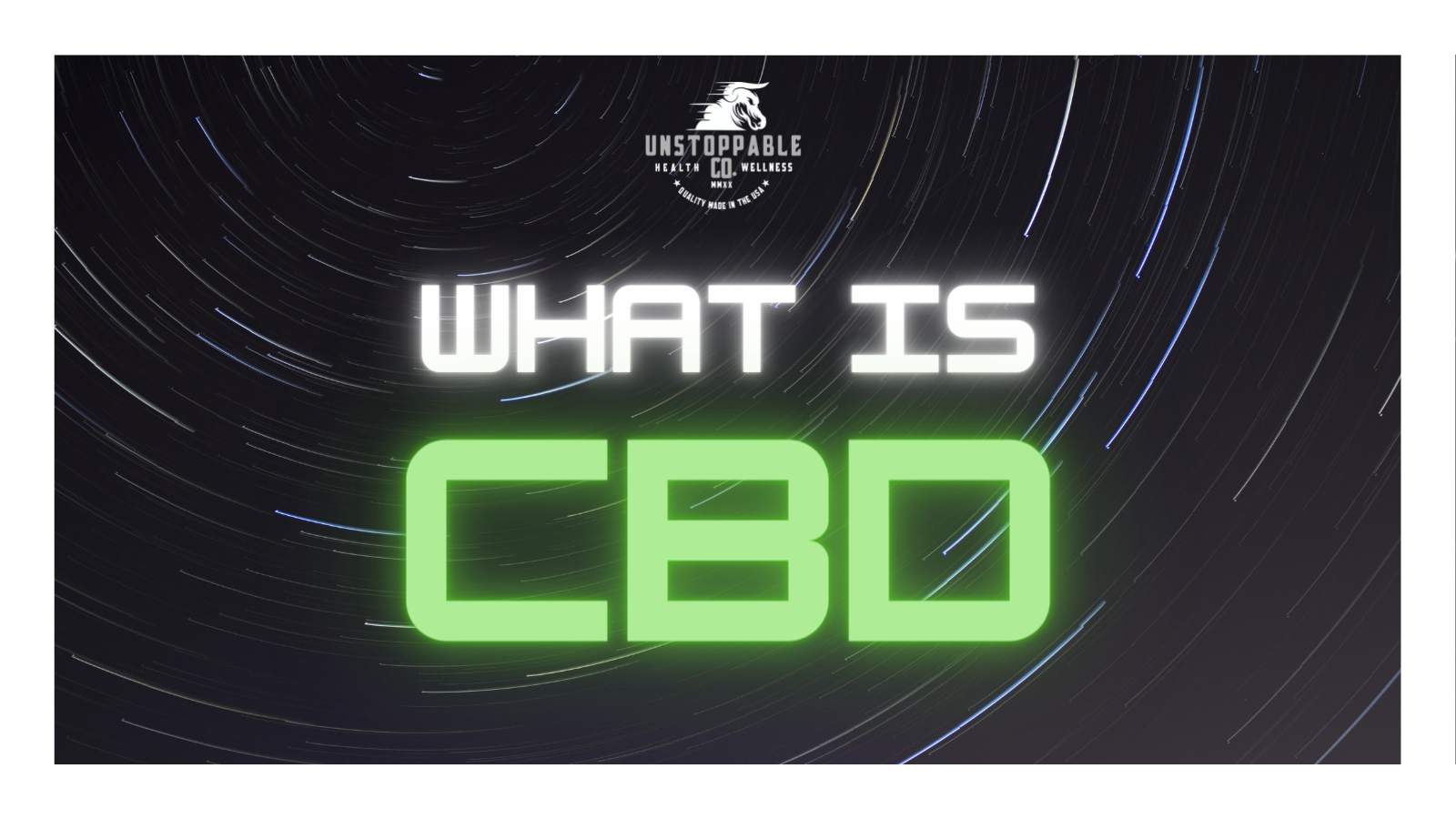
From athletes to the elderly, CBD is gaining popularity. A plant that was once only known as an intoxicating substance is now being reconsidered as a major contender in the wellness world. Now, the compounds from the cannabis plant (namely CBD, cannabidiol) have been used widely to reduce pain, inflammation, anxiety, stress, and even enhance performance. But many of us are left wondering, what is CBD? And how can we make the most of it? Here, we’ll review the basics of CBD and consider what kind of impact it may have for those with active lifestyles.
CBD: The Basics
CBD is the abbreviation used for the compound cannabidiol. Cannabidiol comes from the cannabis or marijuana plant and is actually only one of over 100 naturally occurring chemical compounds found in the plant. Unlike another famous compound in marijuana, THC or tetrahydrocannabinol, CBD is not psychoactive and does not cause users to feel a “high.” This makes CBD a natural choice for those looking for a safe and effective form of relief.
CBD: The Benefits
High-quality CBD products have been studied and promoted for a wide variety of medical problems. One of the most fascinating uses for CBD is in childhood epilepsy, where studies have shown exceptional improvements in those who used the oil internally. But, CBD is also praised for a range of common ailments aside from seizures.
Here are a few of the most common issues that can benefit from CBD:
- Pain
- Athletic recovery
- Inflammation
- Anxiety
- Depression
- Migraines
- Nausea
- Inflammatory bowel disease
- Other mental health conditions
CBD: Is it for You?
![]()
CBD products have been deemed safe for most people by the World Health Organization. But, knowing what kind of CBD is best for you can be tricky if you are new to CBD. Here are a few common ways to use CBD:
Edibles and Sublingual Products
CBD can be found in gummies, capsules, coffee, and even chocolates to help people overcome issues like stress, anxiety, insomnia, and pain.
CBD Topicals (oils, liniments, ointments, lotions)
Topical CBD is an excellent choice for anyone who suffers from pain, stiffness, achiness, inflamed joints and arthritis, or even skin conditions like eczema. Having a go-to CBD topical like Unstoppable is a game-changer for those looking to add a competitive edge to their athletic performance.
Be Unstoppable with CBD
While cannabis is a plant as old as time, modern medicine is finding new ways to use its healing compounds. CBD oil is a safe and natural way to relieve pain and boost the body’s performance, especially for those with an active lifestyle.
Ready to experience the wonders of CBD for yourself?
Shop our Unstoppable collection today!
Unstoppable Support
Will the 2021 Olympics Go on for Equestrians?

The COVID-19 pandemic has put a lot of our favorite events and activities on pause. But few of the events of 2020 had such a heartbreaking impact as the Tokyo 2020 Olympics. While many of us were sad to hear that yet another aspect of normal life was postponed, athletes around the world had to come to terms with the reality that the chance to realize their dreams would have to wait another year.
Many are skeptical about whether the Olympics will actually go on in 2021, considering how changeable and unpredictable the coronavirus is. And if it does go on, what does that mean for the equestrian athletes?
With new COVID-19 guidelines and preparations in place, the International Olympics Committee (IOC) has decided to host the event this upcoming year, in 2021. To keep the event from turning into a super-spreader, the IOC has decided to include fewer events than before which raises great concerns for equestrian fans around the world.
Let’s take a look at the traditional equestrian sports, and what’s in store for equestrians in 2021.
Equestrianism and the Olympics
Equestrianism joined the Olympic Games back in 1900 and includes a series of different team and individual events: eventing, dressage, and jumping. Here are the basics of some of the most popular equestrian games.
What is Dressage?
Dressage is a graceful sport where highly-trained horses carry the rider while performing graceful movements with ease. These competitions demonstrate the level of training, power, and control developed by a rider and their horse. In fact, the riders that participate in dressage competitions are known to have some of the most advanced riding skills.
In the competition, the horses ride at different paces with varying speeds. Horses have to move fluidly in different directions, such as straight lines, circles, sideways, and diagonally.
There are collection and extension movements in which the horse prances by raising the back and legs and reaches the legs further while keeping the neck and back elevated respectively. Put simply, dressage is like a dance – on horseback.
Judging dressage comes down to rating the performance on a scale of 0-10. The rider and horse with the most accurate and graceful movements (and highest points) wins.
What is Showjumping?
Showjumping is a sport that tests a horse’s ability to jump over obstacles inside a riding ring. The course has a preset of 10-16 jumps that range in height and width. There are many tricky turns along with colorful obstacles that test the mental and physical capacity of a rider and the horse.
The rider/horse team has to finish within the stipulated time limit and avoid hitting or knocking over any obstacles along the way. The rider with the fewest penalties, fastest time and lowest number of touches and falls wins.
What is Three-Day Eventing?
This equestrian sport tests the skill, versatility, endurance, and courage of the horse and its rider. The competition spans over three days and comprises three disciplines: cross country jumping, stadium jumping, and dressage.
The arena is typically filled with 40 natural and man-made obstacles. The rider and horse team have to jump or go through the course (around four miles).
The scoring system of the game is based on refusals, time consumed to clear the course, clearing jumps and underpass, the number of times the rider falls off the horse, and other rules by the Fédération Equestre Internationale (FEI).
Will equestrianism be a part of the Olympic Games in 2021?
As far as we can see at this time, equestrians will compete in the Tokyo Olympics in 2021! The IOC has included equestrianism in the reduced list of participating sports for the Olympic Games 2021.
The committee has also rolled a tentative schedule for the events along with the venue. Here is a glimpse of the proposed schedule for equestrian sports.
2021 Olympic Venue: Equestrian Park
Scheduled Dates for Event - Sat 24 July 17:00 – 22:15: Dressage Grand Prix Team and Individual Day 1
- Sun 25 July 17:00 – 22:15: Dressage Grand Prix Team and Individual Day 2
- Tue 27 July 17:00 – 22:40: Dressage Team Grand Prix Special, Dressage Team Victory Ceremony
- Wed 28 July 17:30 – 21:25: Dressage Individual Grand Prix Freestyle, Dressage Individual Victory Ceremony
- Fri 30 July 8:30 – 11:00: Eventing Dressage Team and Individual Day 1 – Session 1
- Fri 30 July 17:30 – 20:10: Eventing Dressage Team and Individual Day 1 – Session 2
Nothing Stops an Equestrian
For equestrian Olympians and non-competitive equestrians alike, nothing can get in the way of pursuing your passion. Through a global pandemic, or simply through a sore muscle, CBD can help to relieve the tension, pain, and stress to keep you riding. Shop the Unstoppable collection of topical pain-relieving CBD products today!
Unstoppable Support
Healthy Pre-Competition Habits to Perform Pain-Free
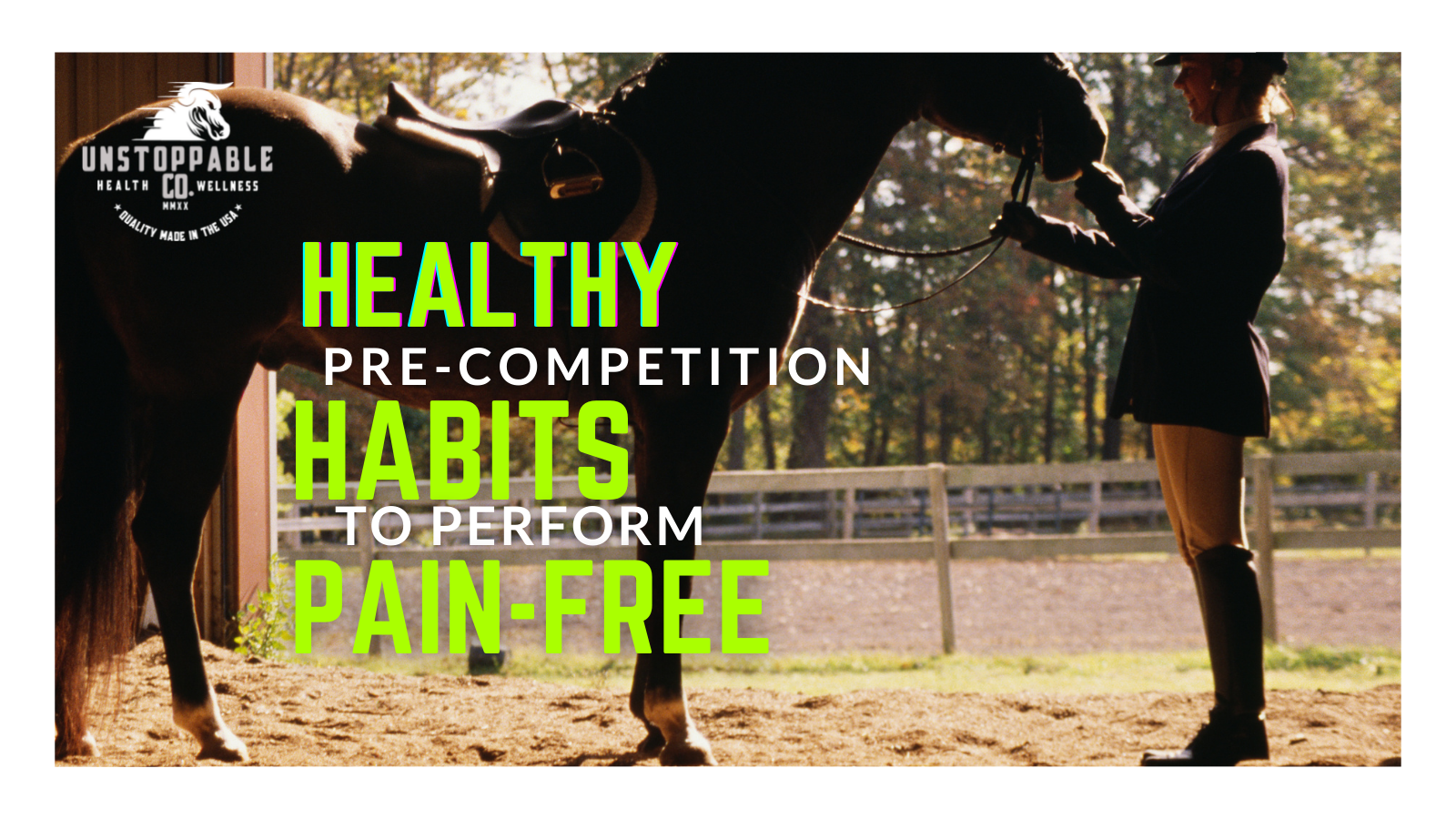
If you ask any competitive equestrian to share the secret behind their success, you will hear words such as practice, perseverance, and patience. All of those essential things contribute to high-performance competition, but they don’t just apply to the ride itself. Riders who have effective pre-competition habits are better able to stay fit and pain-free so they can continue to reach their riding goals.
Here, we’ve outlined the key aspects of a healthy pre-competition routine to help you ride your best – and feel your best after the race is won.
Simple Pre-Competition Habits for Equestrians
A pre-competition routine consists of a set of actions that help riders get ready for their race, both physically and mentally. Riders should focus their pre-competition routine on improving their nutrition, stamina, performance mentality, and injury prevention to ensure that they are in their best shape to perform.
Start With a Pain-Free Plate
Food has the power to make or break your competition. Choose anti-inflammatory foods that keep pain and swelling down while providing essential energy and nutrients to perform at your best.

Colorful vegetables, whole grains, lean proteins, fresh fruit, and healthy fats are great choices for the days leading up to a competition. Avoid inflammatory foods that may increase pain like refined sugar, spicy food, dairy, alcohol, and trans fats. Try to limit beans and high-fiber veggies during the days before and day of competition to avoid any potential digestive discomfort. Filling up on healthy foods will also help to keep your mind clear and focused on competition day.
Warm-Up the Whole Body

On competition day, you’ll want your body to be relaxed, strong, and ready for anything. You’ll also want your mind to be clear, focused, and alert. Starting the day with a simple practice like yoga or tai chi can give you both physical and mental focus to carry out a successful performance, while also encouraging healthy blood flow to all your body’s muscles and joints. A well-stretched body, like a well-oiled machine, is less likely to tense up or become injured during an event.
Prevent Pain with CBD
Because CBD can effectively help relieve pain and stress, it is a favorite choice for riders who are working to manage injuries. But CBD can also be used preventatively as part of a holistic pre-competition routine.

Before a competition, apply Unstoppable CBD cream to any existing problem areas or places to avoid pain creeping in after a competition. For many riders, this includes the wrists, shoulders, knees, and lower back.
As research continues to show the positive effects and benefits of CBD for athletes, it has become a key player in the pre-competition routine for serious equestrians. If you’re ready to improve your performance and prevent pain on competition day – or any other riding day – it’s time to add CBD to your routine. Find your perfect CBD fit in our Unstoppable collection today!
Unstoppable Support
CBD For Athletes: 4 Ways CBD Boosts Performance
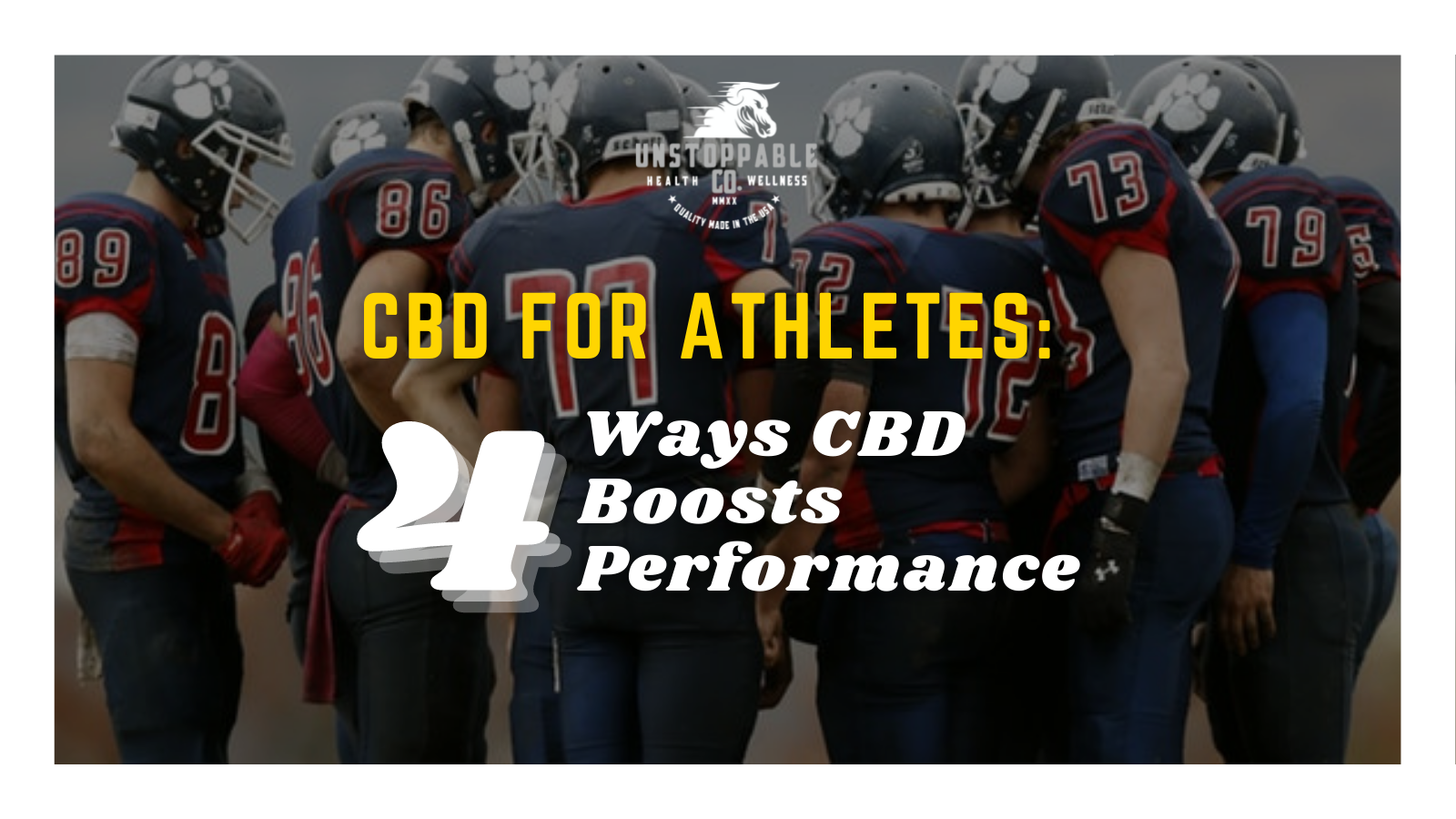
CBD, or cannabidiol, is a powerful natural compound from the cannabis sativa plant. While it has been studied extensively for its ability to calm the nervous system and relieve pain, scientists and athletes alike are now turning to CBD for use in sports medicine.
With several sports personalities such as Lamar Odom, Megan Rapinoe, Rob Gronkowski, and Nate Diaz endorsing the use of CBD products, it’s no wonder that professional and amateur athletes around the world are curious about how these products might boost their performance, too.
Even though the research is limited, the usage of CBD does show promising signs in treating various athletes-related medical conditions such as inflammation, muscle soreness, and joint pain. Let’s explore CBD and its many potential benefits for athletes.
4 Ways CBD Can Boost Performance for Competitive Athletes
-
Muscle Recovery

The most popular reason why athletes like CBD is because it can speed up the recovery process. Faster and more complete healing means competitive athletes can return to their sport quicker and with a lower chance of reinjury. Since CBD is available in various forms such as lotions, ointments, and creams, it helps in alleviating the pain without having to take pain killers.
-
Pain and Inflammation
Athletes train hard and take a knock quite often – whether it’s a fall from a horse, repetitive strain from running, or even overdoing it in the gym, CBD helps athletes increase their pain threshold by interacting with the brain’s endocannabinoid system. Since it improves the pain bearing capacity and recovery, athletes can quickly treat any muscle strain or cramping and get back to doing what they love most.
-
Immune System
Studies show that CBD improves the body’s resistance to stress and infection and generally contributes to a stronger immune system. Since a strong immune system is crucial for physical activity, these properties of CBD allows athletes to maintain their bodies in top condition while they train and compete. This added boost to the immune system is not just helpful for athletes, but for anyone with a weakened immune system.
-
Stress & Anxiety

Athletes might be used to performing in front of large audiences, but that doesn’t mean they don’t suffer from stress or anxiety. Life is stressful as it is, but athletes often have the added stress of daunting performances and anxiety-provoking competition. Thankfully, CBD can help to relieve stress, calm the mind, and allow athletes to perform with less mental pressure.
Do Athletes Really Need CBD?
Athletes, whether amateur or professional, suffer from a range of hardships related to their love of the sport. From muscle spasms to joint pain, overwork to competition stress, athletes experience a range of health issues that need to be addressed so they can continue to perform at their best.Our Unstoppable CBD line offers high-quality care to every athlete. Ready to stay healthy and stay in the game? Shop our collection to find the right CBD product for you.
Unstoppable Support
-
Arthritis Affecting Your Horse-Riding Performance? Fight Back with Nat
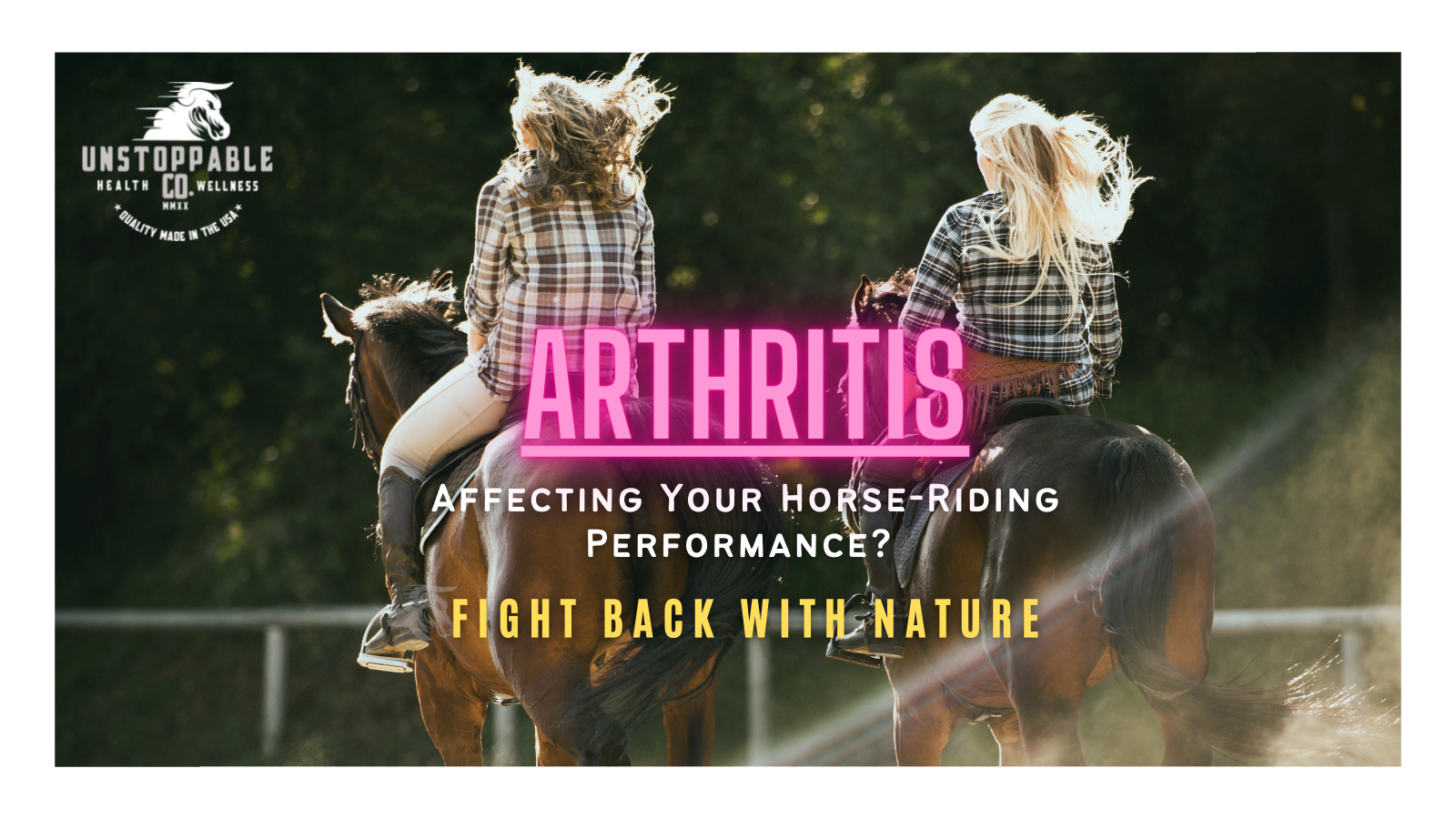
As an equestrian rider, you likely put a good amount of strain on your joints and muscles as you maintain balance on the saddle. While this is often a necessary part of being a competitive rider, this strain can later lead to health complications that attack the joints.
Mild issues may involve pain and soreness, but as time goes on, many riders experience more severe issues like arthritis and bone degeneration. In fact, osteoarthritis and rheumatoid arthritis are incredibly common issues for equestrian riders. Arthritis not only affects a rider’s performance, but can lead to pain and other health issues during daily life.
How can we fight back against arthritis and keep riding for years to come? A healthy lifestyle is the key. Here’s a closer look at arthritis and equestrians – and how nature can help in the form of topical CBD.
Arthritis and Equestrians

Both osteoarthritis and rheumatoid arthritis target the joints. While they affect the body differently, they both eventually reduce flexibility and stiffen the joints, causing intense pain and discomfort.
For an equestrian rider, this is a serious issue. Being unable to use your joints to effectively and painlessly match the cadence and rhythm of your horse can lead to balance issues and poor riding performance.
Does CBD Help Equestrians with Arthritis?
While the treatment for arthritis traditionally includes medicinal therapy and surgical procedures, these solutions can take a toll on riders and may even prevent riders from participating in their passion.
To combat arthritis and prevent future issues, many athletes are choosing a more natural approach to pain-relief. According to a survey conducted by The Arthritis Foundation, at least 29% of arthritis patients use CBD as a treatment for arthritis in liquid or topical form.
The people who use CBD reported significant improvement in physical function, sleep, and other activities. Some of them also reported improvement in pain and stiffness.
CBD and Rheumatoid Arthritis
CBD interacts with specific receptors in the brain to reduce pain and inflammation. Since rheumatoid arthritis attacks the immune system when targeting the joints, this anti-inflammatory effect helps to both relieve pain and help to control inflammation, stiffness, and swelling in the joints.
Is CBD and Effective Treatment Against Arthritis?
Numerous laboratory studies and medical professionals suggest CBD as an effective solution for people to relieve pain and inflammation. The benefits are promising, and more research is underway to learn about how topical CBD can help relieve the pain and suffering caused by issues like osteoarthritis and rheumatoid arthritis.
Stay Unstoppable and with CBD

Equestrians, athletes, or anyone looking to maintain a healthy, active lifestyle may be concerned about arthritis and how it may limit their future. Thankfully, CBD offers a natural solution for the pain and stiffness caused by arthritis, allowing you to stay in the saddle as long as you like. Ready to beat arthritis with CBD? Shop our Unstoppable today!
Unstoppable Support
Goodbye Back Pain: How CBD Can Help Equestrians Ride with Ease
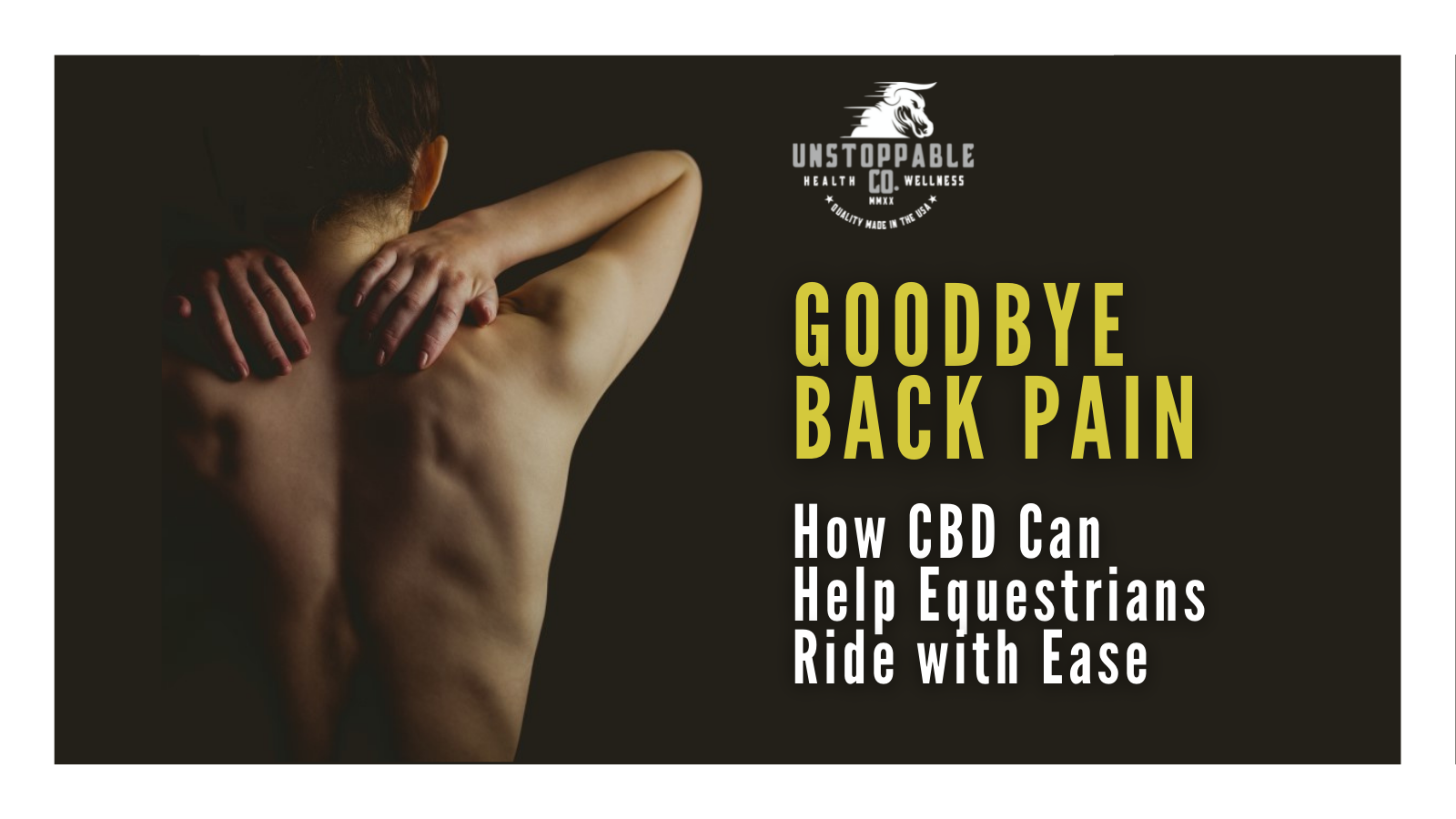 Equestrians spend endless hours on their horses, perfecting their performance. While the sport looks incredibly graceful, what happens in the body of the rider is often anything but.
Equestrians spend endless hours on their horses, perfecting their performance. While the sport looks incredibly graceful, what happens in the body of the rider is often anything but.As the horse moves in varying cadences and rhythms, equestrians must use their back muscles to maintain balance to keep themselves from losing control and getting injured. They regularly absorb the impact of repetitive jolts and potentially harmful pressure. Being exposed to such pressure over an extended period causes equestrians to develop muscle weakness and rigidity. The result? Excruciating, lingering pain that can put an end to a rider’s career.
Thankfully, many equestrians have found a helpful solution for their back pain with CBD. Let’s explore how it’s helping equestrians ride with ease and finally say goodbye to back pain.

How Does CBD Help Professional Equestrians and Amateur Riders?
CBD, or cannabidiol, is formulated from a plant called Cannabis sativa. It is known to have more than 100 chemical compounds that are referred to as cannabinoids. These compounds are known to have anti-inflammatory and analgesic qualities and have been used by athletes around the world to address muscle aches and pains, and here’s why:
-
CBD can improve intervertebral disc degeneration
Many equestrians face chronic back pain due to intervertebral disc degeneration. Disc degeneration is often due to increased inflammation in the joints and surrounding tissues after repetitive minor injuries. Studies show that CBD has anti-inflammatory and analgesic properties that make it a great natural pain-relief choice for many riders to prevent excess damage to their spines and relieve back pain.
-
CBD has anticonvulsant and pain-relieving properties
Doctors often prescribe antidepressants or anticonvulsants to help athletes overcome issues like back pain. But CBD offers a natural alternative to these synthetic drugs, as it has shown to have anticonvulsant and pain-relieving properties.
-
CBD can relax the muscles
The most common type of medicine prescribed to patients with back pain is muscle relaxants. They can reduce back pain significantly, especially if it has occurred due to an injury or overuse, as is common in horseback riders. CBD works by altering the levels of endogenous cannabinoids, like anandamide, to relax the muscles and therefore relieve pain.
-
CBD can reduce insomnia and nighttime pain
 Chronic back pain is one of the main reasons people lose sleep. Conversely, poor sleep and stress can lead to back pain issues. For riders who find themselves tossing and turning at night or even dealing with full-blown insomnia, CBD may help relieve sleepless nights by calming the back pain that keeps you up, while also encouraging restful, stress-free sleep.
Chronic back pain is one of the main reasons people lose sleep. Conversely, poor sleep and stress can lead to back pain issues. For riders who find themselves tossing and turning at night or even dealing with full-blown insomnia, CBD may help relieve sleepless nights by calming the back pain that keeps you up, while also encouraging restful, stress-free sleep.If you’re an equestrian suffering from chronic back pain (or other issues like stress, anxiety, insomnia, or tension) it’s time for a change.
Shop our Unstoppable CBD products and find a natural solution that keeps your riding better, longer, and pain-free.
Unstoppable Support
-

